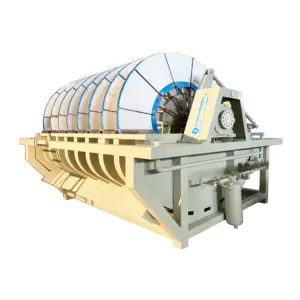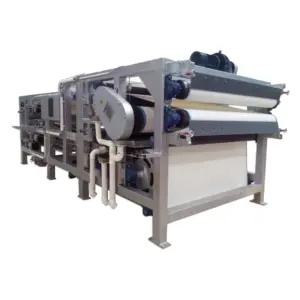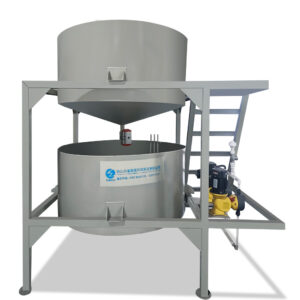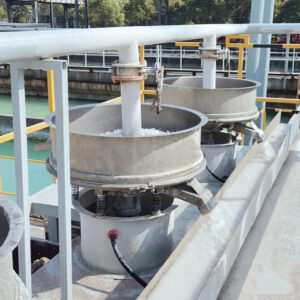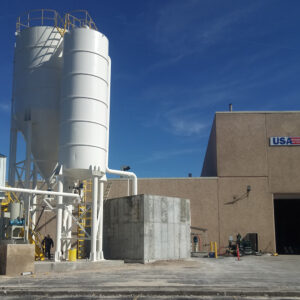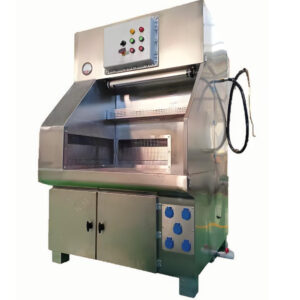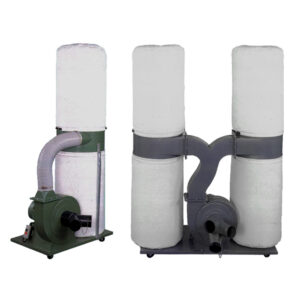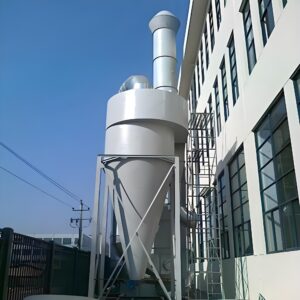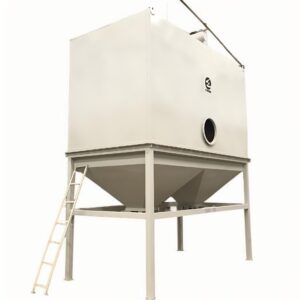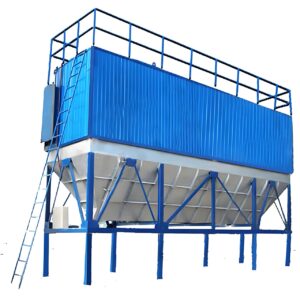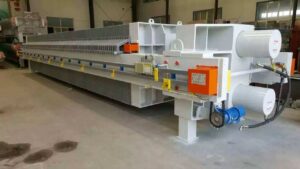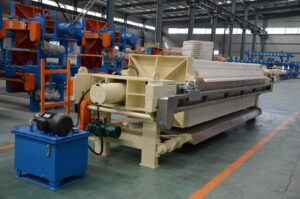Load sensing technology has revolutionized the efficiency and performance of fully automatic filter presses, marking a significant advancement in industrial filtration processes. As industries strive for greater productivity and cost-effectiveness, the integration of load sensing technology in filter presses has become a game-changer. This innovative approach allows for real-time monitoring and adjustment of pressure, ensuring optimal filtration results while minimizing energy consumption and wear on equipment.
The implementation of load sensing technology in fully automatic filter presses has led to substantial improvements in process control, filtration quality, and operational efficiency. By continuously monitoring the load on the filter plates, these advanced systems can dynamically adjust pressure settings, cycle times, and other parameters to achieve the best possible filtration outcomes. This level of precision and adaptability is particularly crucial in industries where consistent product quality and environmental compliance are paramount.
As we delve deeper into the world of load sensing technology in fully automatic filter presses, we'll explore its mechanisms, benefits, and applications across various industries. From the basic principles of load sensing to its integration with advanced control systems, this article will provide a comprehensive overview of this cutting-edge technology and its impact on modern filtration processes.
"Load sensing technology in fully automatic filter presses represents a significant leap forward in filtration efficiency, allowing for real-time adjustments that optimize performance and reduce operational costs."
How Does Load Sensing Technology Work in Filter Presses?
Load sensing technology in filter presses operates on the principle of continuous monitoring and feedback. At its core, this system uses sophisticated sensors to measure the pressure and resistance experienced by the filter plates during the filtration process. These sensors are typically integrated into the filter press carriage, which is why the term "load sensing carriage" is often used in this context.
The load sensing carriage is a critical component of modern fully automatic filter presses. It houses the sensors that continuously monitor the pressure applied to the filter plates and the resistance encountered during the filtration cycle. This real-time data is then fed into the press's control system, which uses advanced algorithms to interpret the information and make necessary adjustments.
By analyzing the data from the load sensing carriage, the control system can determine the optimal pressure needed for efficient filtration. This dynamic adjustment capability ensures that the filter press operates at peak efficiency throughout the entire filtration cycle, regardless of variations in the slurry composition or other process variables.
"The load sensing carriage acts as the 'nervous system' of the filter press, providing crucial feedback that enables the press to adapt to changing conditions in real-time."
| Component | Function |
|---|---|
| Load Sensors | Measure pressure and resistance on filter plates |
| Control System | Interprets sensor data and adjusts press parameters |
| Hydraulic System | Executes pressure adjustments based on control signals |
In conclusion, the load sensing technology in filter presses represents a sophisticated interplay between mechanical sensing and intelligent control systems. This synergy allows for unprecedented levels of precision and efficiency in the filtration process, making it an indispensable feature in modern fully automatic filter presses.
What Are the Key Benefits of Load Sensing in Filtration?
The integration of load sensing technology in fully automatic filter presses offers a multitude of benefits that significantly enhance the filtration process. These advantages span various aspects of operation, from improved efficiency to enhanced product quality and reduced maintenance requirements.
One of the primary benefits of load sensing technology is the optimization of filtration cycles. By continuously monitoring the pressure and resistance during filtration, the system can adjust the applied force in real-time. This dynamic adjustment ensures that the optimal pressure is maintained throughout the process, leading to more consistent and efficient filtration results.
Furthermore, load sensing technology contributes to significant energy savings. Traditional filter presses often operate at a constant, high pressure to ensure effective filtration across various conditions. In contrast, load sensing systems apply only the necessary pressure at each stage of the filtration cycle. This tailored approach reduces energy consumption, leading to lower operational costs and a smaller environmental footprint.
"Load sensing technology in filter presses can lead to energy savings of up to 30% compared to conventional systems, while simultaneously improving filtration quality and consistency."
| Benefit | Description |
|---|---|
| Optimized Filtration | Real-time pressure adjustments for consistent results |
| Energy Efficiency | Reduced power consumption through tailored pressure application |
| Extended Equipment Life | Less wear and tear due to optimized operation |
| Improved Product Quality | Consistent filtration leads to higher quality end products |
In conclusion, the benefits of load sensing technology in filtration are far-reaching. From operational efficiency to product quality and environmental sustainability, this innovative approach addresses many of the challenges faced in industrial filtration processes. As industries continue to seek ways to improve their processes, load sensing technology in filter presses stands out as a key innovation driving progress in the field.
How Does Load Sensing Improve Filter Cake Formation?
Filter cake formation is a critical aspect of the filtration process, and load sensing technology plays a pivotal role in optimizing this crucial step. The quality and consistency of the filter cake directly impact the efficiency of the filtration process and the purity of the filtered product. Load sensing technology enhances filter cake formation through precise pressure control and adaptive cycling.
When a filtration cycle begins, the load sensing carriage monitors the resistance encountered as the slurry is pumped into the filter chambers. As the filter cake begins to form, this resistance gradually increases. The load sensing system detects these subtle changes and adjusts the applied pressure accordingly. This dynamic adjustment ensures that the optimal pressure is maintained throughout the cake formation process, resulting in a more uniform and efficient filtration.
Moreover, load sensing technology allows for adaptive cycling based on the specific characteristics of each batch. For instance, if the system detects that the filter cake is forming more slowly than usual, it can automatically extend the filtration time or adjust the pressure to compensate. This level of adaptability ensures consistent results even when dealing with varying slurry compositions or concentrations.
"Load sensing technology in filter presses can improve filter cake consistency by up to 25%, leading to higher filtration efficiency and reduced variability in product quality."
| Parameter | Impact of Load Sensing |
|---|---|
| Cake Thickness | More uniform across filter plates |
| Moisture Content | Consistent and optimized for each batch |
| Filtration Time | Adaptive based on real-time feedback |
| Cake Release | Improved due to optimal pressure application |
In conclusion, the implementation of load sensing technology in filter presses significantly enhances the filter cake formation process. By providing real-time feedback and enabling dynamic adjustments, this technology ensures optimal cake characteristics, leading to improved filtration efficiency and product quality. As industries continue to seek ways to refine their filtration processes, the role of load sensing in filter cake formation will undoubtedly become increasingly crucial.
What Role Does Load Sensing Play in Maintenance and Longevity?
Load sensing technology in fully automatic filter presses plays a significant role in extending equipment life and reducing maintenance requirements. By optimizing the operational parameters of the filter press, load sensing systems help minimize wear and tear on critical components, leading to longer service intervals and reduced maintenance costs.
One of the primary ways load sensing contributes to equipment longevity is through precise pressure control. Traditional filter presses often operate at constant high pressures to ensure effective filtration across various conditions. However, this approach can lead to unnecessary stress on filter plates, seals, and hydraulic components. Load sensing technology, on the other hand, applies only the necessary pressure at each stage of the filtration cycle, reducing the overall stress on the equipment.
Furthermore, load sensing systems can detect anomalies in the filtration process that might indicate potential equipment issues. For example, if the system detects an unexpected increase in resistance during filtration, it could signal a problem with the filter media or the presence of foreign objects. Early detection of such issues allows for timely maintenance, preventing more serious damage and costly downtime.
"Implementation of load sensing technology in filter presses can reduce maintenance costs by up to 20% and extend the overall lifespan of the equipment by 15-20%."
| Maintenance Aspect | Impact of Load Sensing |
|---|---|
| Component Wear | Reduced due to optimized pressure application |
| Predictive Maintenance | Enhanced through real-time performance monitoring |
| Service Intervals | Extended due to reduced wear and tear |
| Operational Efficiency | Improved, leading to less strain on equipment |
In conclusion, the role of load sensing in maintenance and longevity of filter presses is substantial. By optimizing operational parameters and providing early warning of potential issues, load sensing technology not only improves the immediate performance of the filter press but also contributes significantly to its long-term reliability and cost-effectiveness. As industries increasingly focus on maximizing equipment lifespan and minimizing downtime, the value of load sensing technology in maintenance strategies will continue to grow.
How Does Load Sensing Integrate with Automation Systems?
The integration of load sensing technology with automation systems in fully automatic filter presses represents a significant advancement in filtration process control. This synergy between load sensing and automation not only enhances the overall efficiency of the filtration process but also paves the way for more intelligent and responsive filtration systems.
In a fully automated filter press equipped with load sensing technology, the data collected by the load sensing carriage is seamlessly fed into the press's central control system. This system, typically a Programmable Logic Controller (PLC) or an advanced Industrial PC, processes the load sensing data along with other operational parameters to make real-time decisions about the filtration process.
The integration allows for sophisticated control algorithms that can optimize various aspects of the filtration cycle. For instance, the system can automatically adjust the feed pump speed based on the resistance detected by the load sensors, ensuring optimal slurry flow throughout the filtration process. Similarly, the automation system can use load sensing data to determine the ideal point to end the filtration cycle and begin the cake discharge process, maximizing efficiency without compromising on filtration quality.
"The integration of load sensing with automation systems in filter presses can lead to a 15-20% increase in overall process efficiency, while also enabling more advanced predictive maintenance capabilities."
| Automation Aspect | Role of Load Sensing |
|---|---|
| Process Control | Real-time optimization of filtration parameters |
| Data Logging | Detailed performance tracking for analysis |
| Remote Monitoring | Enhanced capabilities for off-site supervision |
| Predictive Analytics | Advanced fault detection and performance forecasting |
In conclusion, the integration of load sensing technology with automation systems in filter presses represents a powerful combination that drives efficiency, consistency, and intelligence in filtration processes. This integration not only optimizes current operations but also lays the groundwork for future advancements in smart manufacturing and Industry 4.0 initiatives. As filtration technology continues to evolve, the synergy between load sensing and automation will likely play an increasingly crucial role in shaping the future of industrial filtration processes.
What Industries Benefit Most from Load Sensing in Filter Presses?
Load sensing technology in fully automatic filter presses has found applications across a wide range of industries, each benefiting from its ability to optimize filtration processes and improve operational efficiency. While the advantages of load sensing are universal, certain industries have experienced particularly significant improvements in their filtration processes.
The mining and mineral processing industry is one of the primary beneficiaries of load sensing technology in filter presses. In these applications, where large volumes of slurry with varying compositions need to be processed, the ability to dynamically adjust filtration parameters is crucial. Load sensing allows for optimal dewatering of mineral concentrates, improving product quality and reducing energy consumption in downstream processes.
Chemical and pharmaceutical industries also greatly benefit from load sensing technology. In these sectors, where product purity and consistency are paramount, the precise control offered by load sensing ensures that filtration processes meet stringent quality standards. The technology's ability to adapt to changes in slurry composition is particularly valuable in batch production environments common in these industries.
"In the mining industry, implementation of load sensing technology in filter presses has been shown to increase throughput by up to 15% while simultaneously reducing moisture content in the final product by 2-3%."
| Industry | Key Benefits of Load Sensing |
|---|---|
| Mining | Improved dewatering, increased throughput |
| Chemical | Enhanced product purity, batch-to-batch consistency |
| Pharmaceutical | Precise control for high-value products |
| Wastewater Treatment | Optimized sludge dewatering, reduced disposal costs |
In conclusion, while load sensing technology in filter presses offers benefits across various industries, its impact is particularly pronounced in sectors dealing with complex filtration challenges. From mining to pharmaceuticals, the ability to dynamically optimize filtration processes based on real-time feedback has proven to be a game-changer. As industries continue to seek ways to improve efficiency and product quality, the adoption of load sensing technology in filtration processes is likely to expand further, driving innovation and performance improvements across the industrial landscape.
What Future Developments Can We Expect in Load Sensing Technology?
As we look to the future, load sensing technology in fully automatic filter presses is poised for further advancements that will enhance its capabilities and expand its applications. The ongoing developments in sensor technology, data analytics, and artificial intelligence are expected to drive significant improvements in the performance and functionality of load sensing systems.
One of the most promising areas of development is the integration of machine learning algorithms with load sensing technology. These advanced algorithms could analyze historical data from load sensors to predict optimal filtration parameters for different types of slurries, further improving efficiency and consistency. Additionally, machine learning could enhance predictive maintenance capabilities, allowing for more accurate forecasting of equipment wear and potential failures.
Another area of potential advancement is the development of more sophisticated sensors capable of measuring a wider range of parameters. For instance, future load sensing systems might incorporate sensors that can detect not only pressure and resistance but also slurry composition, particle size distribution, and other relevant factors. This expanded data set would allow for even more precise control of the filtration process.
"The integration of artificial intelligence with load sensing technology in filter presses is expected to improve filtration efficiency by an additional 10-15% over current systems, while also reducing unplanned downtime by up to 30%."
| Future Development | Potential Impact |
|---|---|
| Machine Learning Integration | Enhanced process optimization and predictive capabilities |
| Advanced Sensor Technology | More comprehensive real-time data for process control |
| IoT Integration | Improved remote monitoring and control capabilities |
| Sustainability Features | Enhanced energy efficiency and resource optimization |
In conclusion, the future of load sensing technology in filter presses looks promising, with developments on the horizon that will further enhance its capabilities and value to industries. As PORVOO and other industry leaders continue to innovate in this field, we can expect to see filter presses that are not only more efficient and reliable but also smarter and more adaptable to the evolving needs of various industries. The ongoing advancements in load sensing technology will undoubtedly play a crucial role in shaping the future of industrial filtration processes.
Conclusion
Load sensing technology has undeniably transformed the landscape of fully automatic filter presses, ushering in a new era of efficiency, precision, and adaptability in industrial filtration processes. From optimizing filter cake formation to enhancing maintenance strategies and integrating seamlessly with automation systems, load sensing has proven its value across various aspects of filtration operations.
The benefits of this technology are far-reaching, impacting industries from mining and minerals to chemicals and pharmaceuticals. By enabling real-time adjustments based on actual load conditions, load sensing technology not only improves filtration efficiency but also contributes to energy savings, reduced maintenance costs, and enhanced product quality. The ability to dynamically adapt to changing slurry conditions ensures consistent performance even in the face of variable input materials, a crucial advantage in many industrial applications.
As we look to the future, the potential for further advancements in load sensing technology is exciting. The integration of artificial intelligence and machine learning promises to take process optimization to new heights, while advancements in sensor technology will provide even more comprehensive data for decision-making. These developments will likely lead to filter presses that are not only more efficient but also more intelligent and self-optimizing.
In conclusion, load sensing technology in fully automatic filter presses represents a significant leap forward in filtration technology. Its widespread adoption and ongoing development underscore its importance in modern industrial processes. As industries continue to seek ways to improve efficiency, reduce costs, and enhance product quality, load sensing technology will undoubtedly play a pivotal role in shaping the future of industrial filtration.
External Resources
Load sensing system – Liebherr – This article explains the concept of load sensing in hydraulic systems, particularly in cranes, where it adjusts the hydraulic pressure and delivery volume based on the load to optimize efficiency and reduce fuel consumption.
Onboard load sensor for use in freight railcar applications – This document discusses the development and validation of an onboard load sensor for freight railcars, which accurately tracks the load and monitors bearing conditions to prevent overloading and ensure safety.
Load-sensing systems for light-duty trucks – Google Patents – This patent describes systems to prevent overloading in light-duty trucks, including height and weight sensing systems, and systems to monitor towing capacity and strain, providing warnings to the driver when thresholds are exceeded.
Applications of Weight Sensors in Fleets | TruckX Insights – This article highlights the critical role of weight sensors in trucking, ensuring safety, regulatory compliance, and optimized vehicle performance by accurately measuring cargo loads and preventing overloading.
How does Load Sensing work? – Bailey Trailers – This resource explains how load sensing works in trailer braking systems, adjusting the braking effort based on the trailer's payload to improve vehicle stability and prevent over-braking.
Load Sensing Valve – Wikipedia – This Wikipedia article provides a detailed explanation of the Load Sensing Valve (LSV) used in trailer braking systems, its operation, and its benefits in maintaining vehicle stability.
Load Sensing in Hydraulic Systems – Hydraulics & Pneumatics – This article delves into the principles and applications of load sensing in hydraulic systems, including its role in optimizing system efficiency and reducing energy consumption.
Load Sensing Technology – Sauer-Danfoss – This resource from Sauer-Danfoss explains the load sensing technology used in hydraulic systems, focusing on its ability to match pump flow to the actual load demand, thereby improving system performance and efficiency.
